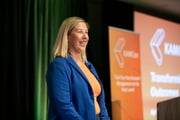How to Build Stronger Customer Relationships with Radically Authentic Discovery
in Key Account Management /It’s essential to understand what the world looks like through the eyes of your customers if you want to become their trusted advisor. That’s why you need to have radically authentic conversations with your customers where you show up as a peer when you’re talking to executives.
We recently hosted a webinar with Bob London of Chief Listening Officers, who has conducted over 2,600 conversations with B2B decision-makers. He showed us how to ask the kind of questions that get responses that provide you with actionable insights from your customers so you can deliver more value.
Bob’s approach, called Radically Authentic Discovery (RAD) involves asking thought-provoking questions without an agenda to engage customers and gain deeper insights.
Why Radically Authentic Discovery (RAD)
Customers are experts in their business, situation, priorities, and challenges, but not your product. That’s why it’s difficult to engage them about your product during a quarterly business review (QBR) or upsell conversation. But, when you start asking questions about them and stay focused without pivoting, they have a lot to say, especially if you listen.
When it comes to listening, customers are practically begging sellers to listen to them.
According to Rain Group two of the top three influences on B2B purchase decisions are:
- 71% - Leading a thorough discovery of my concerns, wants, and needs
- 68% - Listening to me
In fact, the two go hand in hand. You can’t do thorough discovery without actively listening to your customer’s responses. And you can’t deliver meaningful value to your customers without understanding your customers' concerns, wants, and needs.
Although you are in the post-sale world as an Account Manager or Customer Success Manager, you’re most likely dealing with customers who have never been asked why they bought or what they are trying to achieve with your product or service. This puts the customer at risk to churn if a competitor comes in and asks them these questions if you don’t.
What is Radical Authentic Discovery (RAD)?
There are two parts to Radical Authentic Discovery:
- Ask disruptive questions
- Shut up and listen
Ask Disruptive Questions
We ask customers and prospects boring questions like, “What keeps you up at night?” Since customers know that you’re expecting answers that you can convert into opportunities, they say things like “Doing more with less.” This may be the start of an insight, but it isn’t anything you can act on.
By feeding into the boring vendor speak, you aren’t activating the customer’s brain. So, instead, you need to wake customers up and make them think by asking them questions nobody has ever asked them before.
A question of this type that Bob likes to ask is, “If a competitor contacted you tomorrow, would you ignore them or want to learn more? Let’s say on a scale of one to five, where one equals ignore, and five is you get back to them pretty quickly to learn more.”
The customer reactions tend to be something like, “Hmm,” which is a sign that you’ll get a thoughtful response. Or they may say, “That’s a great question,” which is another sign of engagement. Then they say, “No one has ever asked me that before.” And what Bob has learned is that the next thing out the customer’s mouth after that is probably going to be something they have never shared with anybody before. So, that is an insight that can become a competitive advantage for you.
So, consider asking questions that are a little bit different that will wake up the customer’s brain. The customer will remember how you made them feel. They will remember that you made them feel like you were really curious, you cared, and that you took the time to ask questions nobody else had.
Radically Authentic Listening Techniques
When you start asking disruptive questions, it’s essential to shut up and listen. A good start is by using the mute button when talking with customers. But take it further by practicing the following RAD listening techniques so you gain the deepest insights and understanding of what is important to your customers.
1. Start every call with a quiet mind
Set aside 60 seconds prior to each customer call. During this time think about your customer as another human trying to accomplish something in their job. Remind yourself to enter the call curious about the customer’s needs, priorities, and challenges, and NOT your product.
2. Be authentically curious
Customers can tell when you’re authentically curious. It’s when you remain focused on them. And it’s asking follow-up questions to more deeply understand what they said instead of pivoting to your point of view or agenda.
So, start with questions about their company’s priorities and challenges. This helps builds trust and shows them you are genuinely interested. Then be open and patient. Don’t always be thinking about the next question you want to ask. Instead, listen intently and continue asking for more information to gain clarity about what the customer is telling you.
3. Go with their flow
We have a tendency as humans to shift versus support. If you’re talking to a customer, you will get so much more information if you stay with what they’re saying. You can do this by either remaining silent or by asking, “What did you mean by that?” instead of jumping to the next question, agenda item, or slide. Continue the conversation. Remember you aren’t conducting a survey, so ask second level clarifying questions.
4. Don’t solve or sell
Although it is tempting to offer a solution or start selling something to the customer as soon as you identify an opportunity, restrain yourself. You can circle back and discuss the opportunity with the customer at the end of the conversation. You’ll learn more by remaining focused on what the customer is telling you and continuing the discussion.
5. Embrace silence
We tend to want to speak to fill the silence during a conversation, but it’s best to exercise patience by waiting when the customer pauses. Chances are they will continue speaking if you do. So, literally put yourself on mute by employing the mute button. Then if you start speaking, you won’t interrupt the customer, break their train of thought, or miss out on additional insights.
Putting this into practice
Implementing this level of discovery, also known as Voice of Customer (VOC) is easy. Schedule a 30-minute call at least once or twice a year. You can replace one QBR with this call or carve out time in a regularly scheduled meeting to have this kind of step back conversation. Bob has found that this is something customers look forward to. They like talking about these things because they are important to them.
And if your customer currently perceives you as being completely technical or tactical, prep them for this conversation by saying something like, “On our next call I’m hoping we can have some time at the end to do a little bit of a step back conversation.” That’s usually all you need to do to pave the way.
Don’t wait to practice these techniques with customers. Instead, practice with your peers first, so you can make the questions your own and develop your listening skills.
Build Stronger Customer Relationships
Start leveraging RAD to gain a greater understanding of what’s important to your customers. You’ll develop stronger relationships, elevate yourself to trusted advisor status, delivery more value, and reduce churn.
Want to hear more from Bob London? Register for KAMCon at super early bird rates through December 31st.







